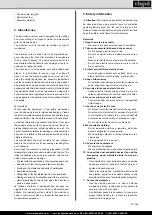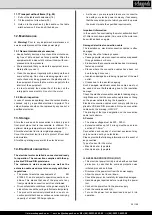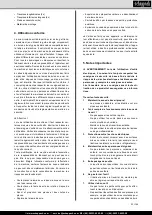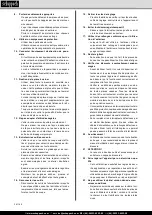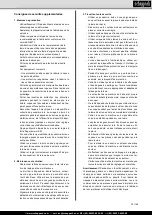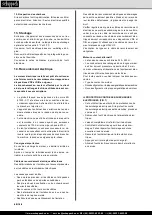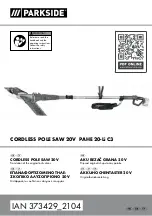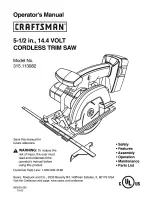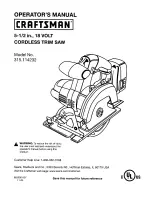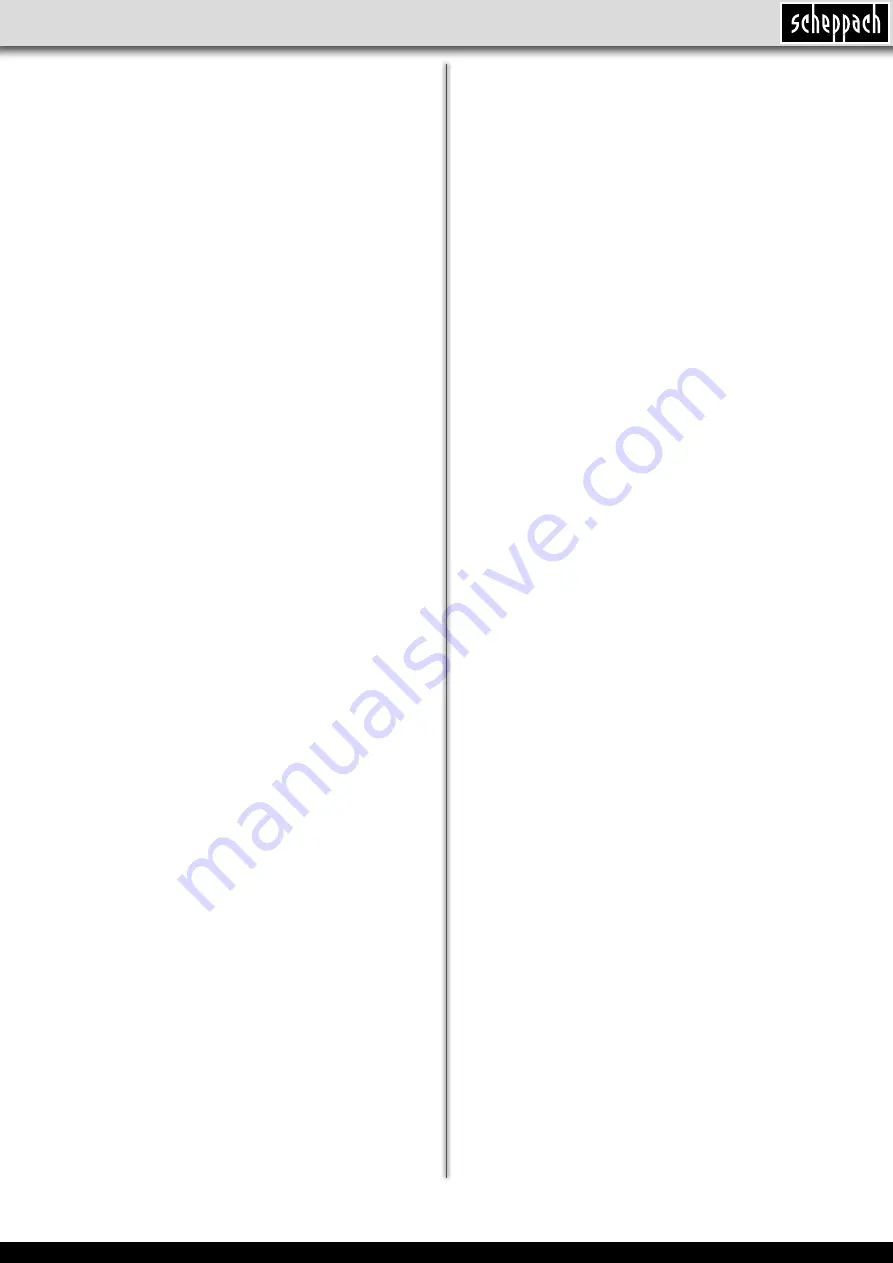
www.scheppach.com
service@scheppach.com
+(49)-08223-4002-99
+(49)-08223-4002-58
25 І 168
www.scheppach.com
service@scheppach.com
+(49)-08223-4002-99
+(49)-08223-4002-58
•
Refitting, including adjusting and measuring
works, and cleaning must be carried out only
when the motor is switched off. -
Disconnect
the main power plug
-
•
Before switching on again, ensure that keys and
adjustment tools have been removed.
Warning!
This electric tool generates an electromag-
netic field during operation. This field can impair active
or passive medical implants under certain conditions. In
order to prevent the risk of serious or deadly injuries, we
recommend that persons with medical implants consult
with their physician and the manufacturer of the medical
implant prior to operating the electric tool.
SAFETY INSTRUCTIONS FOR THE HANDLING OF
SAW BLADES
1
Only use insertion tools if you have mastered their
use.
2
Observe the maximum speed. The maximum speed
specified on the insertion tool may not be exceeded.
If specified, observe the speed range.
3
Observe the motor / saw blade direction of rotation.
4
Do not use any insertion tools with cracks. Sort out
cracked insertion tools. Repairs are not permitted.
5
Clean grease, oil and water off of the clamping sur-
faces.
6
Do not use any loose reducing rings or bushes for
the reducing of holes on saw blades.
7
Make sure that fixed reducer rings for securing the
insertion tool have the same diameter and have at
least 1/3 of the cutting diameter.
8
Make sure that fixed reducer rings are parallel to
each other.
9
Handle insertion tool with caution. They are ideally
stored in the originally package or special containers.
Wear protective gloves in order to improve grip and
to further reduce the risk of injury.
10
Prior to the use of insertion tools, make sure that all
protective devices are properly fastened.
11
Prior to use, make sure that the insertion tool meets
the technical requirements of this electric tool and is
properly fastened.
12
Only use the supplied saw blade for sawing opera
-
tions in wood, materials similar to wood, plastics and
non-ferrous metals (except for magnesium and alloys
containing magnesium).
Residual risks
The machine has been built according to the state of
the art and the recognised technical safety require-
ments. However, individual residual risks can arise
during operation.
• Health hazard due to electrical power, with the use of
improper electrical connection cables.
• Furthermore, despite all precautions having been met,
some non-obvious residual risks may still remain.
•
Residual risks can be minimised if the „safety instruc
-
tions“ and the „Proper use“ are observed along with
the whole of the operating instructions.
–
In times of non-use keep the push stick or the push
block with the electrical power tool in its holder at
all times.
2
Maintenance and repair
–
Pull out the mains plug for any adjustment or re
-
pair tasks.
–
The generation of noise is influenced by various
factors, including the characteristics of saw blades,
condition of saw blade and electric tool. Use saw
blades which were designed for reduced noise
development, insofar as possible. Maintain the
electric tool and tool attachments regularly and if
necessary, initiate repairs in order to reduce noise.
–
Report faults on the electric tool, protective devices
or the tool attachment to the person responsible for
safety as soon as they are discovered.
3
Safe work
–
Use the push stick or handle with sliding wood, to
pass the workpiece securely out off the saw blade.
–
Make sure that the riving knife is always used, and
set up is correctly.
–
Use the upper blade guard and set it to the cor-
rect position.
–
Only use saw blades for which the maximum per
-
missible speed is not lower than the maximum
spindle speed of table saws and which are suit-
able for the material to be cut.
–
Do not cut rebates or grooves without fitting a suit
-
able guard, e.g. a tunnel-type guard, over the saw
table.
–
Circular saws must not be used for slotting jobs
(cutting grooves which end in the workpiece).
–
When transporting the electric tool, only use the
transport devices. Never use the protective devices
for handling or transport.
–
Make sure that the upper part of the saw blade is cov-
ered during transport, e.g. by the protective device.
–
Be sure to only use spacers and spindle rings
specified by the manufacturer as suitable for the
intended purpose.
–
The floor around the machine must be level, clean
and free of loose particles, such as chips and cut-
ting residues.
–
Always stand to the side of the saw blade when
working with the saw.
–
Do not remove any cutting residues or other parts
of workpieces from the cutting zone while the ma-
chine is running and the saw unit is not at rest.
–
Make sure that the machine is always secured on
a workbench or a table if at all possible.
–
Support long workpieces (e.g. with a roller table) to
prevent them sagging at the end of a cut.
–
m
Attention!
Never remove loose splinters, chips
or jammed pieces of wood while the saw blade is
running.
• Switch off the machine to troubleshoot or re-
move jammed pieces of wood. -
Disconnect
the main power plug
-













